For many - many years the city of Gori was the most ordinary city in Georgia. And, probably, it would have remained so ordinary if in 1879 an ordinary boy was not born in an ordinary peasant family of the shoemaker Vissarion Dzhugashvili and his wife Catherine, who was named Joseph or simply Soso, and who later became the leader of the peoples of Russia - Joseph Vissarionovich Stalin.
Now in this famous city there is an equally famous Stalin Museum. Museum, which consists of three parts. And each part tells about some separate period of Stalin's life. There really is something to see and something to be surprised at. In addition, the museum building is the most famous building in the city itself. But let's start in order.
The house where Stalin was born
By a great accident, this house has remained intact to this day. Here the leader of the people was born and here his brothers who were born before, whom he had never seen, died. As a child, little Soso managed to get sick with smallpox, which simply raged here in those distant times. But fate left him to live on, although his parents already believed that their son had one foot in the grave.
This house is small and very modest. According to some reports, he did not even belong to the Dzhugashvili family. The head of the family rented this building to accommodate his family.
But how it really happened, we will never know.
The furnishings of the house are rather poor, but for that time Joseph's family did not live so badly. All objects in this modest and almost ascetic dwelling are preserved exactly in the form in which they were here in those distant times when the formation of the character and personality of Joseph took place.
But Stalin himself probably remembered little from this life, because he was taken away from Gori when he was only 4 years old, and at that age children can remember little.
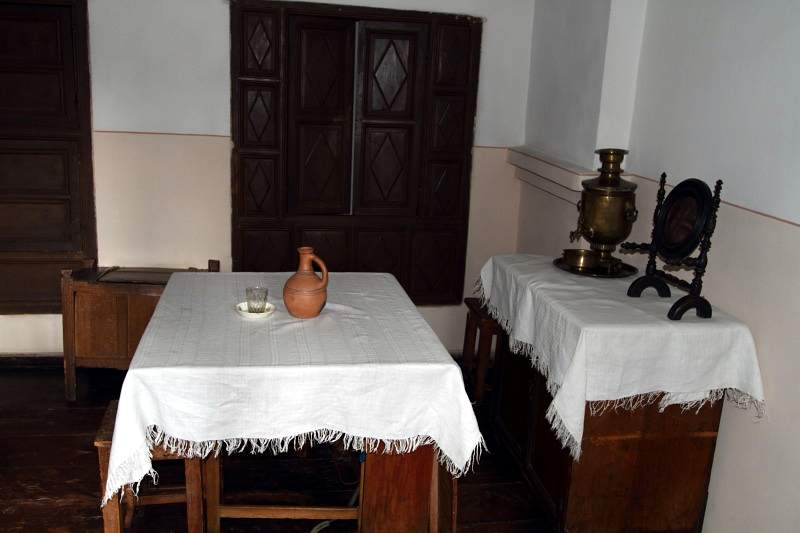
When you wander through the rooms of this house, for some reason you want to be silent. It seems that now a very familiar voice will be heard here, and this voice with such a famous Georgian accent will certainly say something special. It is hard to believe that Stalin himself sat for a long time at this table, which was covered with the most ordinary white tablecloth once upon a time. It's hard to believe that mom or dad on this couch read Georgian books to him and told him Georgian fairy tales about great travels and miracles.
And the little boy Soso listened to his father with great pleasure and did not believe him in the least, although the tales were so convincing and so interesting ...
The house has a special semi-basement room. And this is completely normal. The thing is that such a room was intended to hide there from the heat and summer heat. And such phenomena are very difficult to endure in Georgia. Of course, it was not so cool in the basement, but it was very, very interesting.
Little Soso was very fond of this cellar. For him there was a special world, which he was very surprised and did not understand for a long time why it was so hot outside, but here it was so nice and cool and so nice to play his favorite games.
When you wander through these rooms and examine this small house, it seems that all these objects are looking at you with some kind of dumb surprise and fear. They have been standing here for so many years, in their places, and for so many years the guides have shown them and the guides tell that this jug, this table, this sofa and these chairs are simply afraid that one fine moment all this may end. It seems that they just know what no one else in this world knows. But never - never will they give away their secret, because this secret belongs only to them.
The carriage in which Stalin rode
Not far from the house where Stalin was born, there is a lone carriage in which the leader of the people traveled around the country. Anyone can enter the carriage and look at the modesty that is simply shouting about itself here. And to be surprised that Stalin gave so little value to comfort.
Of course, everyone is interested in visiting the compartment in which Stalin rode. And here it is. A modest room in which there is absolutely nothing superfluous. And personal too. Stalin slept during the journeys in the most ordinary carriage place. And never complained about inconvenience or lack of comfort. Today this peculiar bed is covered with a white sheet, which is so reminiscent of the shroud of a coffin ...
In the carriage except sleeping place there was the most ordinary chair and table, which do not stand out in any way. But all these objects look so lonely in this rather dark room, where the windows are again closed with white curtains, that you want to leave here as soon as possible.
It is unbearable to be here for a long time. Because you understand that all this does not belong either to you or to this car. All this belongs to him - to the man who lived, slept and worked here. And all these things look at you with a mute reproach, and they smell of insane orphanhood.
The next room is the meeting room. No portraits, no embellishments or farce. Only a table and chairs, a full-length mirror and white sconces. And, of course, the curtains. By the way, the color of the interior of this car is selected only in a double color scheme - it is white and brown.
There is also a kitchen in Stalin's carriage, and two toilets - one for the leader of the peoples, the other for everyone else, and several compartments for those accompanying him.
I don't want to walk on this car for the second time. I don’t want to talk loudly or touch something. All these things that have come to our time from the last century belong to only one person. And from every chair on which Stalin sat, from every table at which Stalin sat, and even from the walls and ceiling of this carriage, a kind of barely noticeable breeze of the past blows, which will simply never be our present again.

Stalin Museum
This is perhaps the most interesting must-see place in Gori. In front of the museum itself, behind the house in which Stalin was born, stands his monument. The monument is full-length, still the same simple and completely uncomplicated. Here Stalin is no longer depicted as a young man, but as a man who has long developed his own idea of the world (the monument was dismantled in 2010).
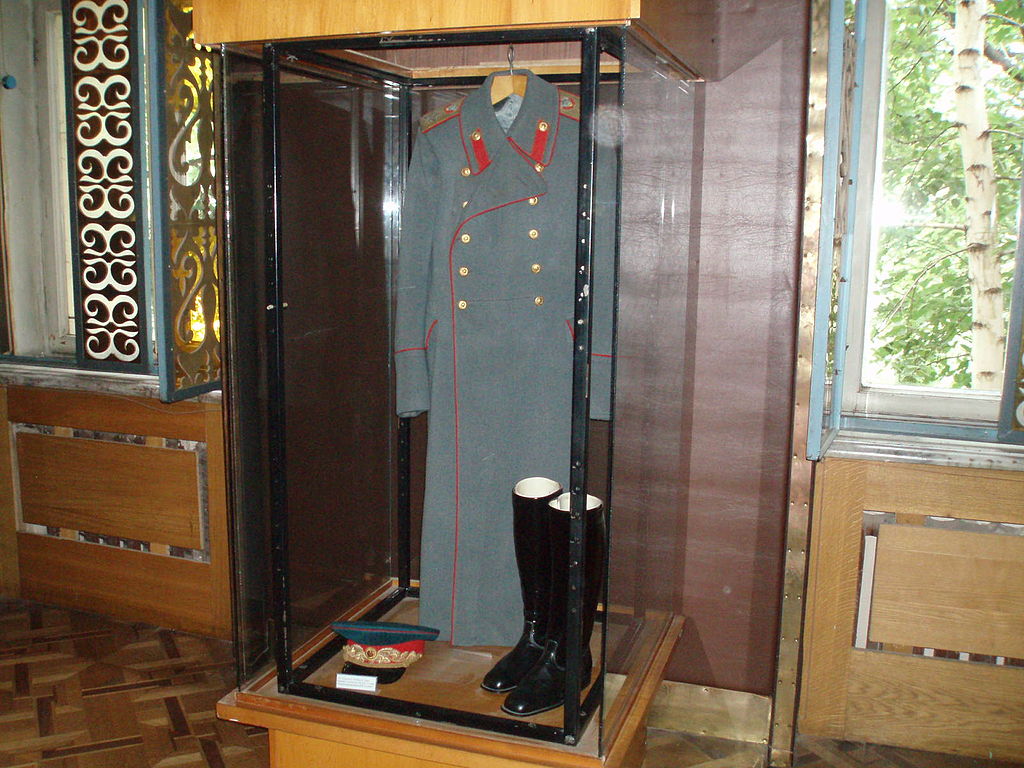
The Stalin Museum in Gori is divided into several rooms. The first hall is filled with a variety of papers, photographs, documents, certificates, poems of Stalin himself, maps. Everything here is literally seething with history in faces and portraits. But all this is not so interesting.
It is much more interesting to look at the death mask of the leader, which was removed from his face after the spirit of Joseph left his body. However, it is difficult to judge a person by this mask. After all, this is just an object that is on display. Now, if only the soul were on display ...
But that doesn't happen.
Therefore, one has to be content with only what is.
On another stand, you can carefully examine the cigarettes that Stalin loved to smoke so much. You will not feel the smell of tobacco, however, there is only one fact that it was these cigarettes that belonged to a person with such famous name makes you stop in front of them and just look ...
museum building, colony at the entrance![]()
A very interesting place in this museum is the hall of gifts that were given to Stalin. Not surprisingly, this room has quite a few exhibits. Here you can see a silver tray with the face of the Leader, and a wide variety of vases and jugs, and homemade household items. But the central place of this hall is occupied by two overcoats of Joseph Stalin and his boots. The most common boots that he wore at almost any time of the year. And the most ordinary overcoats, which no longer carry the spirit of the owner, because in this glazed space they are now just hanging.
Hanging, useless. And if you connect your imagination, then you can imagine that at night, when the lights are turned off in the museum, boots and overcoats are conducting a leisurely and barely audible conversation among themselves about what was so long ago, about what they still remember and will never forget. ...
And, finally, in the museum you can see an exact copy of Lenin's Mausoleum in Moscow, when Stalin's body was placed there along with Lenin's body. And on the sign of the building were written at once two names of two extraordinary personalities - Lenin and Stalin.
STALIN MUSEUM IN GORI - A FAR JOURNEY TO GEORGIA
By midday I arrived in the city of Gori, which is the birthplace of the General Secretary of the Central Committee of the All-Union Communist Party of Bolsheviks, Generalisimus of the USSR, Comrade Joseph Vissarionovich Stalin.
The only street in the world of Stalin remained in Gori. 
And one of the few monuments to Stalin. Main monument, which stood in front of the Gori administration, was dismantled in 2010, and only a small monument has survived in the State House-Museum of I.V. Stalin. Behind Comrade Stalin, there is a house in which he spent his childhood, the house is protected by a shelter building, by analogy with the Lenin memorial in Ulyanovsk. 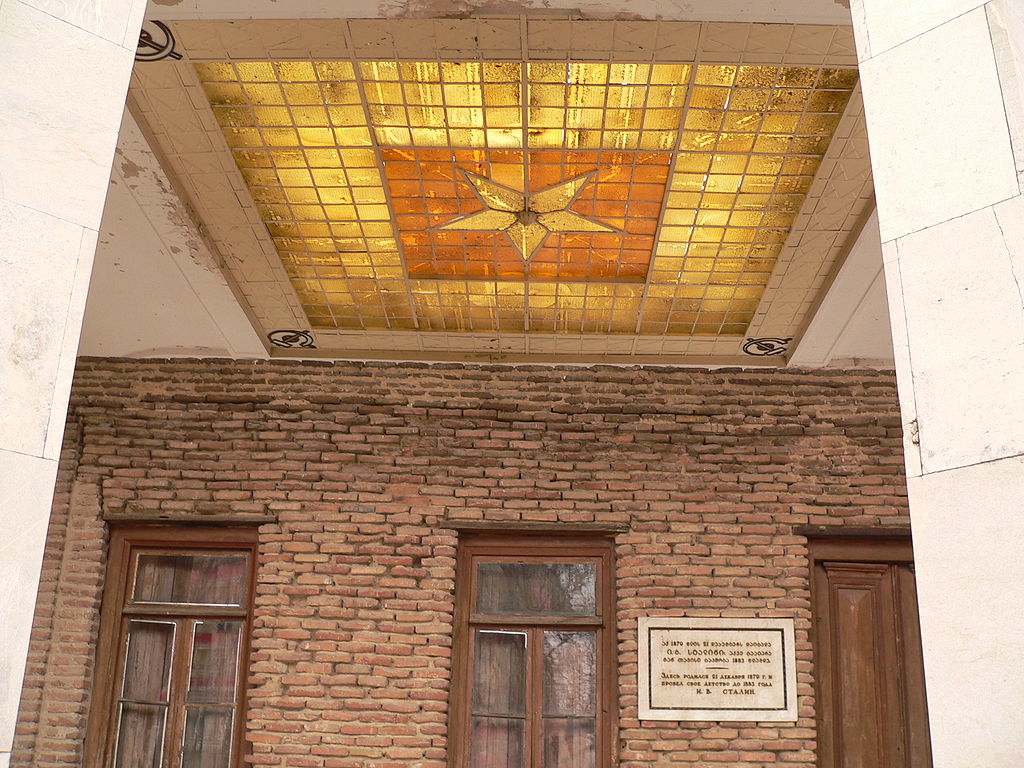
Unlike V.I.Ulyanov (Lenin), who was born and grew up in a complex of three houses, including even a separate house for servants, Comrade I.V. Dzhugashvili (Stalin) grew up in very cramped conditions. Stalin's father was a shoemaker-handicraftsman, and Lenin's father was an inspector of public schools, something like the Head of OblONO in a modern way.
The atmosphere inside the house is very puritanical, here again the family of Joseph Vissarionovich to the family of Vladimir Ilyich, as to the moon.
Entrance to the part of the museum, which tells about the adult life of Comrade Stalin. The cost of a full ticket is 15 GEL.
The entire exposition remained from the Soviet times, which is why it is valuable. The beginning of the exposition, the stand "IV Stalin - a professional revolutionary". Not like today's professions, wait, there are no such professionals left, some "effective managers" and other heroes of our time.
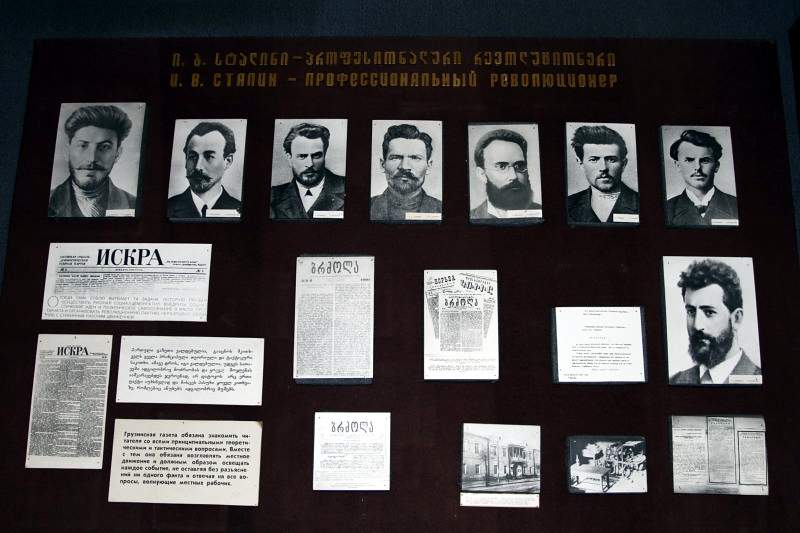
A stand with explanations about how comrade. Stalin professionally led the tsarist secret police by the nose, complements the neighboring stand "Arrests, Exiles and Escapes of IV Stalin". Nevertheless, sometimes the gendarmerie, with its professionalism, managed to surpass the professionalism of Joseph Vissarionovich.
The furnishings of the Kremlin cabinet comrade Stalin. As you can see, everything is modest, the phone is not foreign, the table is not mahogany, the working chair does not look like a throne, the chairs for visitors are also simplicity itself.

A hall in which gifts are collected from citizens of various countries, delegations, officials and labor collectives, to Comrade Stalin, as well as his personal belongings. In the right corner one can see the greatcoat, cap and boots of Comrade Stalin. I did not notice the famous pipe, but I think I was just looking badly.
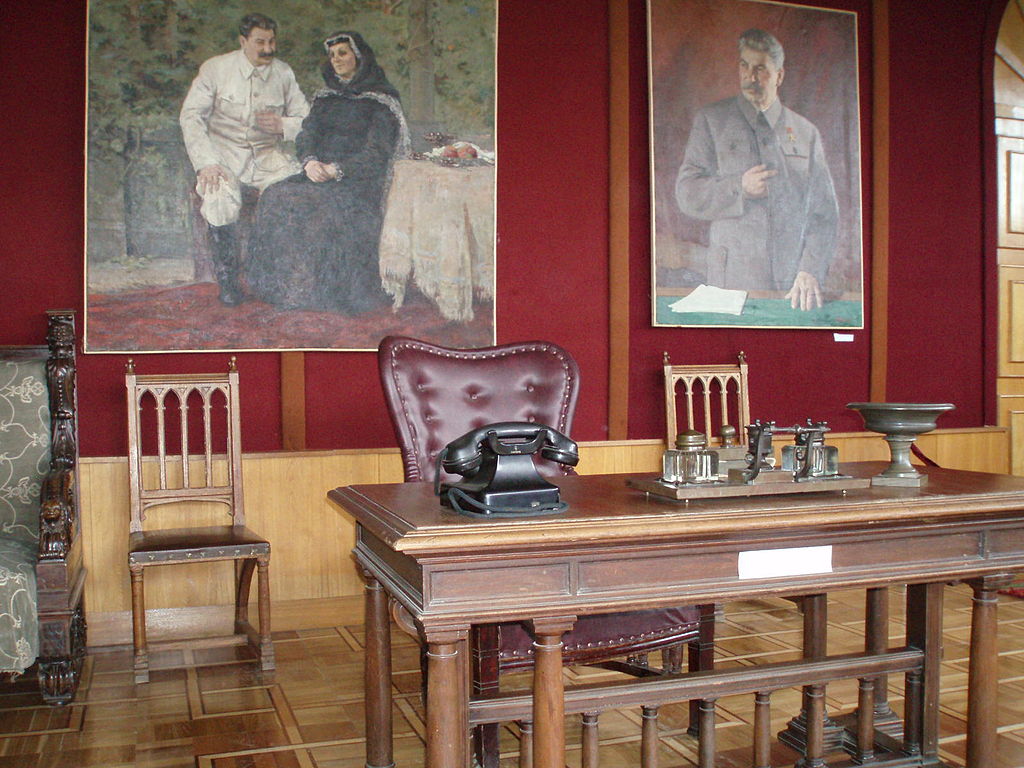
In the courtyard of the museum there is a personal carriage of Comrade Stalin, which he borrowed from Nicholas II.
The compartment in which Comrade Stalin drove.
A salon for audiences and meetings, in which many decisions, both good and not so, that were fateful for the country and its citizens were made.
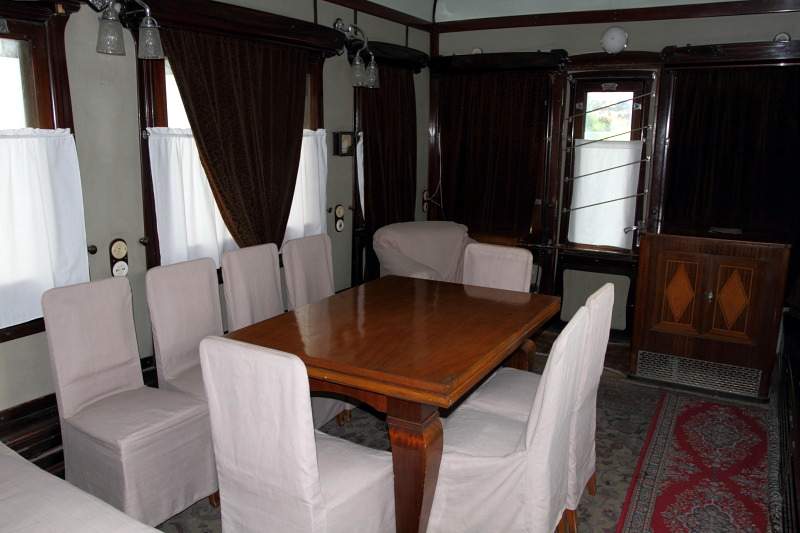
Having finished visiting the Stalin Museum, I left Gori for Tbilisi, intending to quickly see Mtskheta on the way. In ancient times, Mtskheta was the capital of Georgia, but now the lower part of the city is an exemplary tourist village, and the upper part is an ordinary urban area interspersed with five-story buildings.
GORI CITY - STALIN'S HOMELAND
Gori (cargo გორი) - a city in eastern Georgia, the center of the Shida Kartli region and the center of the municipality of the same name. Founded by David the Builder.
The population is approximately 50 thousand.
The city is located in the Kartli Valley at the confluence of the Kura River and its tributary, the Bolshaya Liakhvi River. The city is surrounded by mountains from the south and west.
Gori is located 76 km from Tbilisi and 33 km from Tskhinvali.
Fortress Gori 1642, depicted by the Italian missionary Cristoforo de Castelli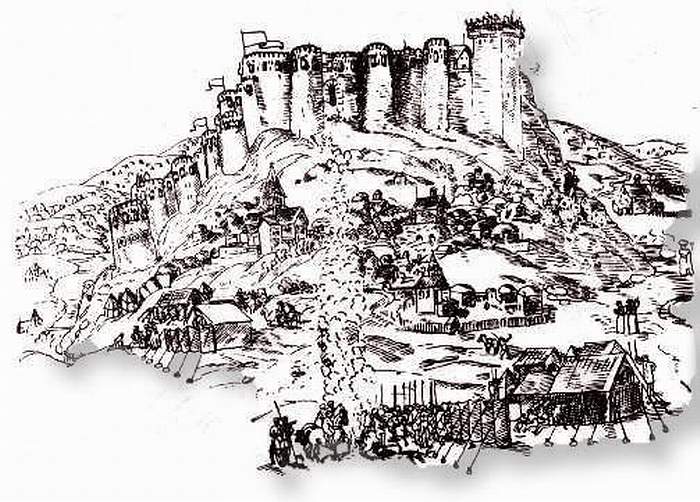
Gori is one of the oldest cities Georgia. Gori received the official status of the city in 1801. The city takes its name from the rock formation (goraki) in the center of the city, on which the remains of the ancient Goris-tsikhe are located.
Gori was first mentioned in chronicles from the 7th century AD. e., although some sources connect the foundation of the city with the reign of David IV the Builder at the beginning of the XII century. Archaeological materials indicate that urban-type settlements existed on the site of Gori long before the beginning of our era, starting from the early Bronze Age (about 3 thousand years BC). Ceramic ware typical for the Kura-Arak culture was found. In 1946, a landslide near the northern wall of Goris-tsikhe exposed a layer from the times of ancient antiquity. Thin-walled clay "qvevri" (vessels for wine), red-painted tiles, and shards of dishes made of burnt red clay were found. The discovered layer dates from the 1st century BC to the beginning of our era. Ancient burials discovered in the eastern part of Goris-tsikhe were found to be about the same age.
Pottery shards, necklaces, coins, bracelets and other jewelry were found in the burials. In 1292 the Alans, led by Tsarevich Bagatar, captured the fortress city of Gori with the adjacent lands, fortresses and settlements. In 1306, the last Alanian king Bagatar died. The Georgian king George V, having united his vassals, fought against the Ossetians.
In 1326, after a three-year siege, he occupied Gori. Pursuing the Ossetians, George V made a hike in the mountains, reached Daryal, Aragvsky and Ksan gorges.
In 1477, the Shah of the Ak-Koyunlu state unexpectedly attacked Gori, taking the city without a battle, but leaving it soon. In the middle of the 16th century, the Iranian Shah Tamaz I seized Gori for a short time. By the end of the 16th century, Gori became a bridgehead for the Ottoman Turks.
In 1599, the Georgian king Simon I unexpectedly attacked Gori and took it by storm, killing the Ottoman garrison.
In 1614, the Iranian Shah Abbas I took Gori and from here led the further conquest of the country. According to the French traveler Jean Chardin, by the 70s of the 17th century, Gori was a significant shopping center... In 1723 the city was ravaged by the Ottoman Turks. For several years the city was under the rule of the Ottomans. From 1735 the city was owned by the Persians. But in the 40s of the 18th century, the city was finally liberated from the conquerors.
It was severely damaged during the 1920 earthquake.
In 2006, Georgian President Mikheil Saakashvili announced the construction of a second (the first - in Senaki) modern military base in Georgia in Gori.
In August 2008 military base occupied by Russian troops during the aggravation of the armed conflict in South Ossetia.
Gori is distinguished by the special positive attitude of the majority of its inhabitants towards the personality of the native of the city of Joseph Stalin.
There is railroad station Burn.
On the Gori - Tskhinvali section in 1969-1979. experiments were carried out on electrification railways direct current with a voltage of 6000 volts.
There was also a city trolleybus network in Gori. It was liquidated in March 2010.
Ruins rise above the city medieval fortress Goristsikhe. 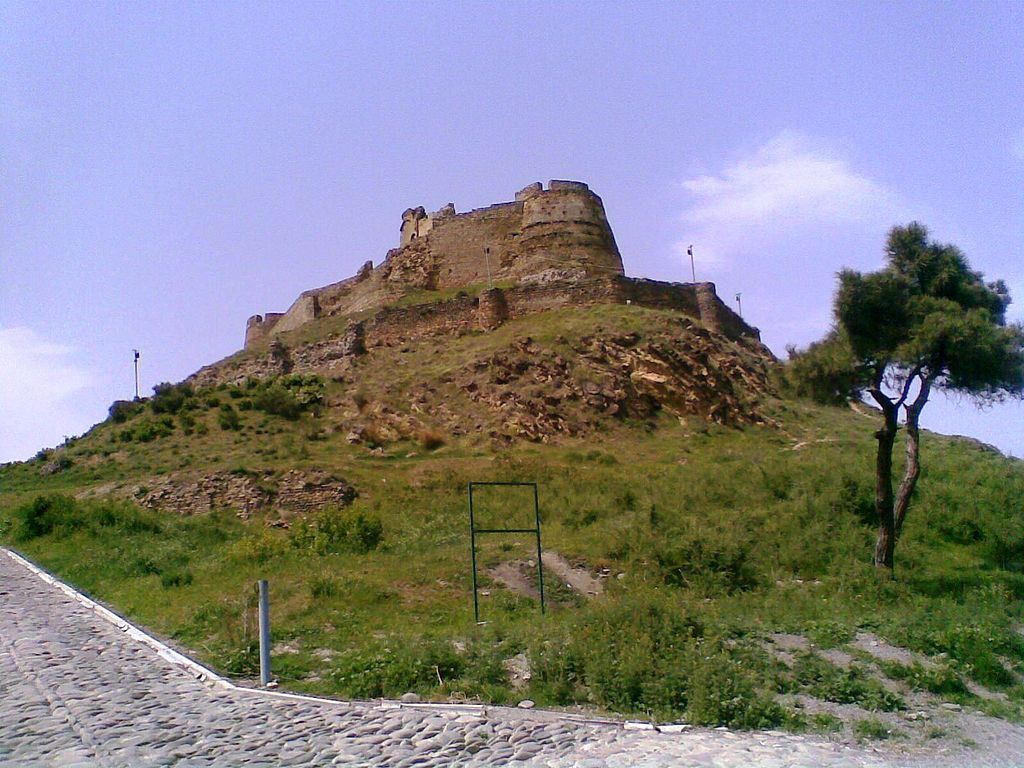
In 1920, the Gori earthquake occurred in the city, which destroyed the Church of St. George (Gevorg), the Church of the Holy Ascension, the Church of St. Stepanos, the Norashen Church, the Vank temple complex.
Stalin Museum.
MONUMENT TO STALIN IN THE MOUNTAIN
The monument to Stalin in Gori is a sculptural work dedicated to the Generalissimo of the Soviet Union I.V. Stalin.
It was located in Stalin's homeland in front of the city hall.
The height of the statue is 6 meters, the three-tiered granite pedestal is 9 meters.
Installed in 1952, during Stalin's lifetime.
Survived during Khrushchev's campaign to dismantle the monuments to Stalin. As Irakli Kandareli stated: “They wanted to remove the monument in 1956 and even tried to do it, but then the whole Gori got to its feet, and nothing happened.
The population pitched tents and guarded the monument day and night so that it would not be demolished on the quiet. "
The monument was created by the sculptor Shota Mikitidze and architects Archil and Zakharia Kurdiani.
The image of the leader on the legendary Georgian wine 
Dismantling
On October 3, 2008, the Georgian State Minister for European and Euro-Atlantic Integration, Deputy Prime Minister Giorgi Baramidze proposed to remove the monument to Joseph Stalin from the center of Gori and make it part of the exposition of the Museum of Russian Occupation, which was planned to open in the city of Gori in the building of the Stalin House Museum ...
The initiative was supported by the Prime Minister of Georgia Vladimir Gurgenidze.
On the night of June 24-25, 2010, the monument was dismantled for later relocation. A monument dedicated to those killed during the August 2008 war will be erected in its place.
The dismantling of the statue was organized at night, “to avoid protests from local population, some of which are categorically against the transfer of the monument. " At the same time, the surrounding area was cordoned off, journalists were not allowed to take pictures.
monument to Stalin, which was dismantled
DISMANTLING THE MONUMENT TO STALIN
The monument to Stalin in Gori was dismantled last night (25.06.2010) from the central square of the city. Now the monument will be installed on the territory of the house-museum of the Soviet leader, which is located a few hundred meters from the center of Gori, Interfax reports, citing representatives of the local mayor's office.
The authorities decided not to warn the residents of the city about their sole decision, so the empty square in front of the mayor's office came as a surprise to the townspeople, Novosti-Gruziya reports with reference to the Imedi radio station.
Dismantling was carried out for several hours at night, while police cordoned off the square. All these details raise doubts that the proposal to demolish the monument would be greeted with glee locals- fellow countrymen of the "father of nations".
Meanwhile, the central square will not be empty. On the site of the monument to Stalin there will be a monument to "the fallen heroes of the war with Russia in August 2008". The square will also be renamed in their honor.
The Georgian authorities made a proposal to move the monument two years ago. "Stalin was the founder of the Soviet Union and the executioner of millions of people," the deputy prime minister said. "In a country that is a symbol of freedom, it is unacceptable for a monument to Stalin to stand in the center of the city, despite the fact that he was an ethnic Georgian. In democratic Georgia, he must have his own place," integration, Deputy Prime Minister Giorgi Baramidze.
By "its place" was meant the "Museum of Russian Occupation", which they wanted to open in the Stalin's house-museum. However, these plans have not yet been implemented, and the State Museum. I.V. Stalin is still dedicated to this "outstanding personality", as noted on his official website.
exposition at the Museum of Soviet Occupation in Tbilisi
The renaming of the square and the erection of a new monument are associated with the events of August 2008, which the Georgian side called an invasion and after which Russia was accused of capturing South Ossetia and Abkhazia. According to Georgian media reports, Russian troops bombed Gori.
However, in May of this year, ex-speaker of the Georgian parliament, leader of the opposition party "Democratic Movement - United Georgia" Nino Burjanadze made a sensational statement.
According to her, there is reason to believe that during the August war the center of Gori was bombed by the Georgian military.
Burjanadze also said that the press said about the bombing of Gori "a little differently" and promised to explain it later, Rosbalt reports, citing the politician's interview with the Kviris Palitra newspaper. If these data are confirmed, the construction of a monument to those who fell in the fight against Russia in the center of the city will look like at least a controversial decision of the authorities.
______________________________________________________________________________________________________________________
SOURCE OF INFORMATION AND PHOTOS:
Team Wandering.
http://www.tamartour.ru/wellcome-to-georgia/about-georgia/information/museum-theatre/stalin-museum
Wikipedia website.
Great Russian Encyclopedia,
http://www.udarnik-truda.ru/puteshestviya/georgia-2011/georgia-2011.htm
http://newsru.com/world/25jun2010/
Address: Gori
Gori, Shida Kartli, Georgia
Gori is called the heart of eastern Georgia. He is administrative center regions of Shida Kartli and Gori municipality. It is the second most populous city and the largest city in central Georgia after Tbilisi, with a population of 50 thousand people.
Gori is one of the oldest cities in Georgia. Gori got its name from a rock formation (goraki) located in the center of the city. On this rock are the ruins of Goristsikhe - a medieval fortress.
Map location and climate
The city is located in the Kartli Valley, at the confluence of the Kura and Liakhi rivers. The city is surrounded by mountains from the south and west.
The distance from Gori to Tbilisi is 73 km, and from Gori to Tskhinvali - 33 km.
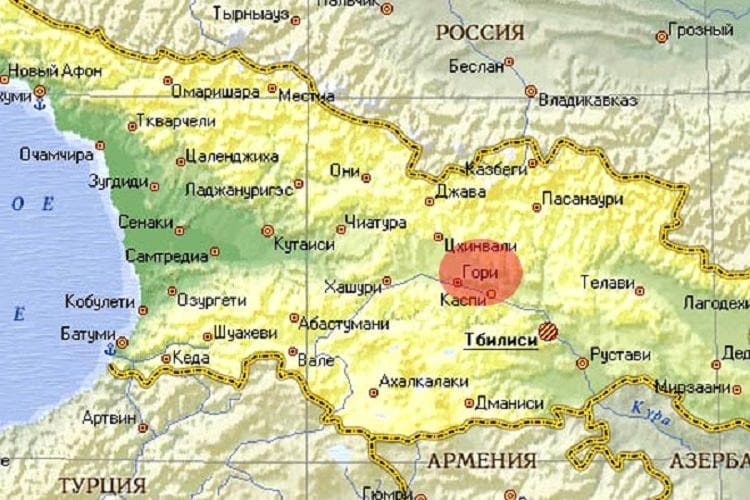
Gori location on the map
The climate in this region is moderately warm and humid.
The landscape here is very diverse: mountains, valleys, rivers, lakes and artificial reservoirs, mountain springs - all this provides great opportunities for the development of tourism in Gori and in the Shida Kartli region.
Features of the city
Gori has a very rich history, the first mention of this city dates back to the 7th century AD. In 1920, the Gori earthquake almost completely destroyed the city. And in the 1930s, they began to rebuild and rebuild it anew.
This city gained worldwide fame thanks to Joseph Dzhugashvili, who was born in these parts. He is better known as Joseph Stalin.
The central street of the city is Stalin Avenue. It divides the city into 2 parts, east and west. Eastern the city is not of interest to tourists, since there is a private sector of residential buildings. All interesting and necessary infrastructure facilities are located in the western part of the city: market, bus station and other facilities.
Stalin Avenue is crossed by Chavchavadze Avenue. This is the second most important street in Gori. All the establishments of city life are collected here: shops, restaurants, hairdressers and much more.
The market in Gori can be called important subject infrastructure of the city, as it is the main source of food and things for the entire Shida Kartli region.
There are not many hotels in the city, the reason for this, apparently, is that there are not many tourists here. People come here for a couple of hours passing to another city.
However, over the past couple of years, several streets have been restored in the city, and now the city has become more interesting for tourists and more suitable for long-term living in it.
The local population practically does not speak Russian. Only the older generation, which caught the time of the Soviet Union. Young people usually know English.
Sights of Gori
Gori is considered not the most interesting cities Georgia from a tourist point of view. However, there are several attractions here - these are architectural monuments, museums and theaters.
Because of the Gori earthquake, there are no architectural monuments in the city, only their ruins. All the antiquity of the city is conditional, since the city was rebuilt anew, and you can see only buildings of the Soviet era.
The main attraction and ancient symbol of the city is Goristsikhe- a medieval defensive fortress. Its ruins are located on a hill in the central part of the city. From this fortress you can observe a picturesque view of the city and the mountains that surround Gori.
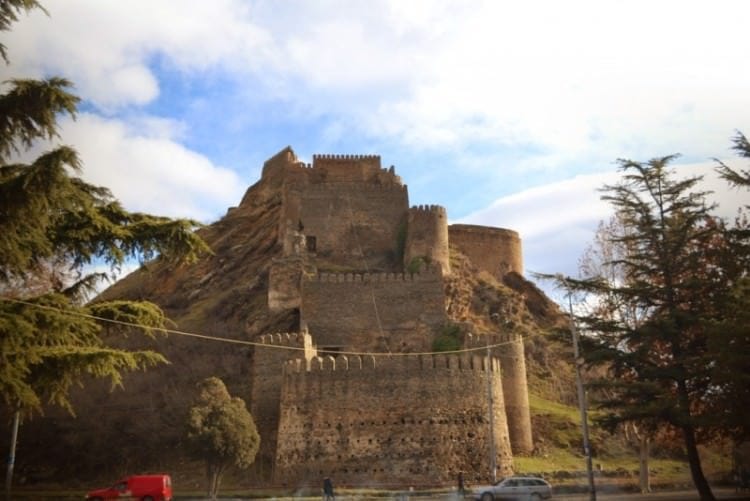
Medieval fortress Goristsikhe in Gori
Another significant attraction of Gori is. The museum is located in the city center, was built in the 1950s around the house where Stalin was born and lived.
The museum is divided into 3 parts: the museum itself, the house and the carriage. The museum contains elements that reflect all aspects of the leader's life. It exhibits such exhibits as documents, letters, photographs of Stalin, his personal belongings, busts of the leader made of various materials and other items. There is also a special exhibit in the Museum - Stalin's armored carriage.
The museum is open from 10.00 to 17.00, the ticket price is 15 GEL.

Stalin Museum in Gori
Also in Gori there is Historical and Ethnographic Museum and War Museum... The ticket price for these museums is 3 GEL.
Located not far from Gori. You can get to it by car or by sightseeing bus. Old City carved into the rock on the banks of the Kura River. This is perhaps the most interesting attraction in the region.
Traditionally, Gori, like other cities of Georgia, has House of Justice, which can be considered a landmark and a monument of modern architecture.
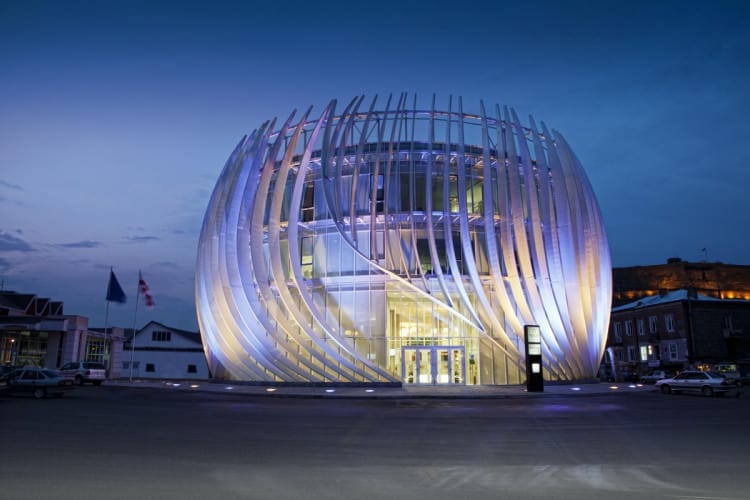
Gori modern architecture - House of Justice
Hotels
There are few hotels in the city, their advantage lies in the affordability of prices. The cost of a room in the Gori hotel is equal to the price of a hostel in Tbilisi.
The main hotel in the city is Intourist. Located on Stalin Avenue opposite the Stalin Museum. This is a Soviet building with 3 floors. The cost of the room is from 60 to 80 lari.
Hotel Georgia is located next to Intourist on Stalin Avenue. Wi-Fi and hot water... The cost is from 70 to 120 lari.
Hotel "Victoria" is a new building, built in 2000. Room cost - from 60 GEL.
There are 2 guest houses in the city - "Maria" and "Svetlana". Guesthouses operate according to European standards, Wi-Fi is available, the cost is 30 GEL.
Want to save money while traveling? Write to us! The Viva-Georgia project was created in order to make rest in Georgia popular and affordable, therefore we provide discounts from 5 to 25% for and help to rent the best ones.
Transport
You can get to Gori by minibus and train.
The bus station is located on Chavchavadze Avenue, it serves intercity minibuses.
Minibuses to Gori run from Tbilisi, Batumi, Kutaisi, Borjomi, Kobuleti and other cities. The cost ranges from 6 to 15 lari, depending on the distance. The minibus schedule can be viewed at the station.

Train Station
Also on the territory of the station there is a cafe, a canteen and a market.
Minibuses from Tbilisi to Gori leave from Didube station.
You can also get to Gori from Tbilisi by train. Gori railway station accepts trains going from Tbilisi to the west of Georgia and in the opposite direction.
The station has 2 platforms and 3 tracks; in just a day, up to 15 trains pass through the station.
Gori has picturesque nature and interesting sights. In addition, the restoration of the city is now underway, and soon it will not be inferior in beauty to other cities of Georgia.
Do you want to come here? The Viva-Georgia team will organize an excursion or tour for you, make the best travel route and provide any other assistance in your trip.
Gori (Georgian) is a city in eastern Georgia, the center of the Shida Kartli region and the center of the municipality of the same name. Founded by David the Builder.
The population is approximately 50 thousand.
sights
- The ruins of the medieval fortress Goristsikhe rise above the city.
Topographic maps
- Gori map sheet. Scale: 1: 100,000. Edition 1975.


History

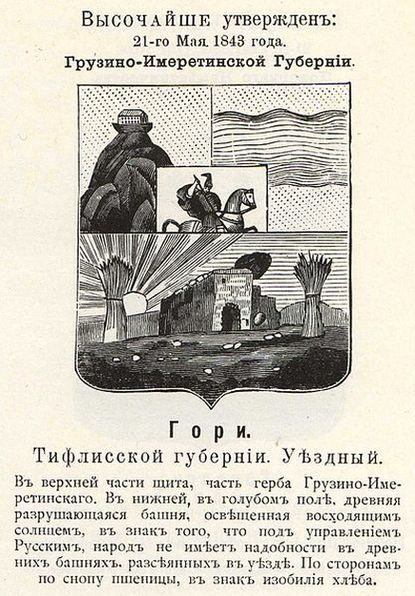
Gori is one of the oldest cities in Georgia. Gori received the official status of the city in 1801. The city takes its name from the rock formation (goraki) in the center of the city, on which the remains of the ancient Goris-tsikhe are located.
Gori was first mentioned in chronicles from the 7th century AD. e., although some sources connect the foundation of the city with the reign of David IV the Builder at the beginning of the XII century. Archaeological materials indicate that urban-type settlements existed on the site of Gori long before the beginning of our era, starting from the early Bronze Age (about 3 thousand years BC). Ceramic ware typical for the Kura-Arak culture was found. In 1946, a landslide near the northern wall of Goris-tsikhe exposed a layer from the times of ancient antiquity. Thin-walled clay "qvevri" (vessels for wine), red-painted tiles, and shards of dishes made of burnt red clay were found. The discovered layer dates from the 1st century BC to the beginning of our era. Ancient burials discovered in the eastern part of Goris-tsikhe were found to be about the same age. Pottery shards, necklaces, coins, bracelets and other jewelry were found in the burials.
In 1477, the Shah of the Ak-Koyunlu state unexpectedly attacked Gori, taking the city without a battle, but leaving it soon. In the middle of the 16th century, the Iranian Shah Tamaz I seized Gori for a short time. By the end of the 16th century, Gori became a bridgehead for the Ottoman Turks. In 1599, the Georgian king Simon I unexpectedly attacked Gori and took it by storm, killing the Ottoman garrison. In 1614, the Iranian Shah Abbas I took Gori and from here led the further conquest of the country. According to the French traveler Jean Chardin, by the 70s of the 17th century, Gori was a significant trade center. In 1723 the city was ravaged by the Ottoman Turks. For several years the city was under the rule of the Ottomans. From 1735 the city was owned by the Persians. But in the 40s of the 18th century, the city was finally liberated from the conquerors.
It was severely damaged during the 1920 earthquake.
There are two such cities (besides Norilsk, where I live): Vologda, where I was born, and Gori. The advantages of living in the latter in those distant times were obvious: firstly, people in Georgia generally lived better, and secondly, my grandparents had an apartment in the city and good house in the village, plus several plots of land with apple trees and grapes, besides, my grandfather worked at the Gori cotton factory as a foreman and was a very respected person. In general, by today's standards, my Gori relatives were wealthy. Meanwhile, my parents and I continued to huddle in a one-room Norilsk apartment. And then everything collapsed, the town-forming Gori industrial complex was closed and my grandfather's pension was not enough even for a bus ticket to the village, because of which he was forced to walk more than ten kilometers in one direction. Before those events, I appeared in Gori every summer during school holidays, and after that I not only did not have such an opportunity, but I did not even know anything about whether my relatives were alive or not, the connection did not work, the mail did not reach (the Georgian Post is still that cesspool, in any case, I sent postcards to my relatives a couple of times from abroad (not even from Russia) and as expected, they did not reach). Then I came to Gori as an adult in the late 90s, by that time the city was in deep depression and was slowly dying. Now, of course, something is slowly being restored here, but its former glory industrial center he can no longer see. So, my mother's irrational decision to leave there in the mid-eighties, perhaps, saved me from the fact that I could get into the lost generation of people of my age, who grew up in the 90s in the Georgian outback and could neither get an education nor get a normal life in life. ... In general, I remember this city from three sides: what it was in Soviet times, then in the dashing 90s and what it is now.
This is what the city center looks like from a height. (Photographed during the flight Tbilisi-Mestia, a story about it.) From time to time I will refer to this picture to make it easier to navigate.
Goris-tsikhe, top view. It can be seen that apart from the walls, the fortress is nothing else. As interesting and imposing as it is on the outside, it is just as uninteresting on the inside. Although I was told that 40-50 years ago there were still some passages, but then someone fell asleep and all these rooms were either blown up or dismantled.
View of the fortress from the bridge over Liakhvi:
In different sources, the age of the fortress is indicated differently. The brochure about Gori says that Goris-tsikhe was founded in the 7th century, and the English Wikipedia says about the 13th century. The fortress received its present appearance in the 1630s during the reign of the Kartlian king Rostom Khan and later in 1774, when Irakli II was the king of united Georgia. At one time a Russian battalion was located in the fortress (1801). In 1920, a strong earthquake occurred in Gori, as a result of which Goris-tsikhe was seriously damaged. By the way, although there is basically no information about this, I believe that the earthquake actually destroyed appearance cities. There are only a few mansions and buildings from the time of tsarist Russia, and the strength of the earthquake can be judged by the information that several (at least five) Armenian churches were destroyed that day. Naturally, with the advent of Soviet power, no one began to restore them.
The most preserved part of the fortress is called the Nine Gates or Nine Exits (Tskhra-kara):
We climb up, the main entrance is visible:
He is from the inside:
Prongs. Judging by the ideal condition, the fortress was restored.
View of the private sector towards the road to Tbilisi. Many small houses with brown roofs in the background are houses of refugees from South Ossetia. The river in the frame is Mejuda.
View to the other side. The river is Liakhvi. The building with a semicircular roof is a city market combined with a city bus station. I have come across postcards that depict the market and the bus station square in the 50s and 60s. Photos show that it was very beautiful here then. Now it’s complete horror, the territory is dirty for hundreds of meters around, garbage is thrown into the river, besides, people relieve themselves under the walls of the fortress and even behind the memorials ... For a couple of years they have been saying that the market will be moved, and a park zone will be arranged here, but for now the matter has not moved, although it must be done. Notice in this shot the building under construction right in the center and the chimney on the left.
On the site of the building under construction, there was once a monument to Lenin, around which I rode a pedal car as a child, but a wave of popular anger in 1991 demolished the monument. Another monument "Lenin and Stalin in Gorki" was previously in the city park, on which the leaders sat on a bench, but even Stalin's presence did not help this monument, it was also destroyed. The building under construction turned out to be the police on my next visit.
And the pipe is almost the only surviving structure on the territory of the former Gori cotton mill. The Great Soviet Encyclopedia says: the plant included 2 spinning and 2 weaving factories and a finishing plant, high-quality fabrics were produced: coarse calico, flannel, Maya, tartan, pique, etc. Construction of the plant began in 1947; in 1951 the first products were produced. But photo (2) shows that even the walls were not left from the plant (a large spot in the lower right corner), people took everything away. The pipe was interesting to me, because they tried to bomb it during the conflict in August 2008, apparently believing that there were some communication devices on the pipe, although there was nothing but honeycombs. As you can see, they did not hit the pipe, but what flew in left behind a large funnel (you can see it a little in the photo), and the explosion knocked out windows in houses in the vicinity.
Other interesting places around Goris-tsikhe. Cathedral Of the Most Holy Theotokos. I did not find out the year of construction, but it looks like the temple is about a hundred years old.
Church residence opposite the cathedral:
Some kind of memorial. It has been standing here for a long time, I remember it from childhood. To whom it is dedicated I do not know.
Fragment:
And this sculptural composition was staged after August 2008. It is difficult to say what it means in appearance, the roofing felts are dedicated to the fallen soldiers, the roofing felts say that they have lost parts of their bodies (like Georgia is part of the territory), but everyone is sitting at a round table and is still in the ranks. Somewhere I came across information that it is dedicated to those who fell in the battles for the fortress, but I somehow doubt that this is so. I am addressing the question about the meaning of the monument to those who read me in Georgia, you should have been told about it on TV for sure ... I, unlike many who spoke negatively about this monument, liked it.
Fragments:
Another old monument near the fortress. In Georgia, monuments are often not signed, so I don’t know to whom this particular one was put, by the way, local ones too.
Another urban antiquity is the small fortress-monastery of Gorijvari (Gori Cross) with the Church of St. George. It is not located exactly in the city, but on the outskirts at the top of one of the mountains. Now it is the main cult place in Gori, especially in Georgoba (St. George's Day), when the whole city gathers here. During the already mentioned earthquake of 1920, Gorijvari was destroyed, but the inhabitants rebuilt it. There is no monastery here now, the temple and the walls make an impression only from the outside. But it makes sense to climb here, the place is sacred, and the city from here at a glance.
Another view at a different time.
View of the evening city from Gorijvari:
And in the other direction there is a view of the Kartli Valley. Kura is reflected in the rays of the setting sun.
Now let's move on to the main city square, which bears the name of Stalin (in the photo (2) it is located a little higher than the fortress), which is natural because the leader was born in Gori.
Panoramic view:
Until 2010, right in front of the entrance to the mayor's office, on a nine-meter pedestal, there was a six-meter monument to Stalin (erected in 1952 during the life of the leader), who even survived total de-Stalinization. The monument remained standing on the personal order of Khrushchev, because the people resisted the attempt to demolish it. Stalin was carefully dismantled at night and taken away in an unknown direction under the pretext that he would later be installed near the museum. At the same time, they began to prepare the foundation for the installation of the monument, but 2 years have passed, and the monument has not yet been installed. The locals do not believe that it will be installed at all, but I am sure, because in my opinion there is nothing to hide; if the authorities are not stupid, they will understand that Stalin is the main tourist attraction in Gori and should be used.
Now this place is bare, for some reason even beautiful fluffy spruces have been removed:
And here it was supposed to be transferred, but then, as always, the money ran out):
"Tourist corner":
The building to the right of the City Hall was once a department store; now it is divided by banks. With the coming to power of Saakashvili, street displays began to be installed in many cities of Georgia, such a display was also on this building, but during the conflict it was shot. For some reason, the square was also bombed, they say that the target was the city hall building, but they did not hit the building itself (this version seems ridiculous to me - in our time it is like not hitting an elephant from three steps). By the way, a Dutch journalist died on the square.
Opposite a department store, like a sports school or a gym:
The street on which the building of the mayor's office is located, as it is not difficult to guess, is called Stalin Street. Let's walk along it first in the direction of the department store.
First, there are "stalinkas" on it:
Then faceless "Khrushchevs". Here, as well as in Georgia in general, a squatter (and it was not difficult to legalize it before, now it is almost impossible) can occupy up to half of the house, disfiguring the look of the courtyard beyond imagination.
And at the very end there is something completely terrible late Soviet:
Following this an architectural wonder multi-storey buildings are ending, the Kura flows here, across which a bridge is thrown, and on the other side there is already a predominantly private sector. If you cross the bridge and look around, you get the following view.
If you go even further, you can see the building railway station, there is nothing more interesting here. At this station, my grandfather and I bought Soviet-style Pepsi-Cola (it was the only place in the city where it was sold, but in Norilsk it was not at all) and went by train to the nearest station and then returned, so he walked me. This was my favorite pastime.
On the other side of the city hall, literally three houses away begins small park, where the Stalin Museum is located, and across the street from the park there is the Museum of Military Glory and the Ethnographic Museum. The next post will be about museums.
General view of the park:
Hotel Intourist, followed by Hotel Georgia:
The building of the telephone booth and post office:
On the same road you can get to the Tbilisi highway. In that direction you can see this building with a clock:
The cluster of several five-story buildings now looks like new. But in 2008, the houses were badly damaged during the war. A rocket the size of a large refrigerator flew into one of the apartments. There are a lot of photos on this topic in the network ... There is also an article in WIKIPEDIA.
In memory of those events, the following tree was installed from the shells:
A stone wall at the very exit from the city with an unusual monument to the philosopher Merab Mamardashvili. For some reason, I have a feeling that in my childhood this head was also here, but on the Internet I found information that I installed it quite recently.
45. Whoever has tried freedom will never give up on it.
The contents of the head of a philosopher according to the sculptor. In general, I remember very well that they told us a lot about Mamardashvili in philosophy and even, it seems, in sociology, when I was studying at the institute, but the fact that he was a Gorian became clear only when I started writing this post.
To the left of the City Hall, perpendicular to Stalin Avenue, is Chavchavadze Street, on which the following objects are located.
Gori University:
With another unsigned monument:
A cinema that has already been opened and closed several times because people did not go to it. Now it does not work again.
Gori Drama Theater:
Only on one house in Gori you can see traditional Georgian carved balconies:
A kind of monument (naturally not signed):
Behind the monument you can see the mansions of tsarist times, which in the past belonged to some princely families. These two buildings can be called historic center Burn.
What was not destroyed by the very earthquake of 1920 was destroyed by the notorious and so beloved in Georgia squatter. Although, sometimes you can meet houses that look more than a hundred years old, but there are very few of them here.
When the authorities announced that they would restore historical Buildings, I just threw up my hands - where can they be here? But when the layers of plaster and all sorts of extensions were removed, under them there was an old brick, laid out several generations ago. In general, when I was there the last time (in March and April this year), several streets looked like this. Let's see how it will look after restoration.
If you walk along Chavchavadze street from the city hall, then it will lead to the bus station and the fortress, then it will pass over the bridge over Liakhvi and turn into Mira street, about which a little later. In the meantime, I'll show you the city park, it is located across the street from the bus station (see photo (2): the stadium and the entire green area are nearby - this is what it is).
General form:
I rode on this wheel back in Soviet times, and it still works:
Cars, there were huge queues here:
A completely children's attraction. I remember that I wanted to sit at the helm, which was almost impossible due to the number of people willing:
Umbrella. Although it gives the impression of neglect, almost all of these swing-roundabouts work in summer, just most of the photos were taken in winter.
Sculpture in the park. I already wrote somewhere that in Georgia there are many similar sculptures of a near-erotic nature)
Since the park is also named after Stalin, here too there is a monument to him with such a preserved plate:
Now we will cross the bridge and go out to the police station, which is in the photo (11). This is where Mira Street begins, and everyone calls the area the Combine, although by now there is no stone unturned from the Gori industry.
These are the ones they ate here in the summer:
And in winter, completely different tones. The same house, view from the other side:
The houses on Mira Street are made of Armenian tuff, and this street can deservedly be called the most beautiful in the city. In general, tuff is very widespread in Armenia, rich Armenians from other countries even manage to take tuff to their place of residence and build houses from it, apparently, in order to have a constant reminder of their homeland. It is the number one building material in Armenia.
I don’t know what kind of building it is, it looks like there are some kind of sports clubs and dances.
P.S. Traditional old house "with a cuckoo" in a village near Gori, there are not many such houses left. The first floor is made semi-basement, so that in the heat it was a little cooler.
P.P.S. Bonus. A few frames in the end.
A drawing of questionable content in the park (it seems, has not survived to this day). Pay attention to the cop)
Shop in the fence:
Artifact:
UPD. Interesting photographs of Gori in 1964, in which houses with tiled roofs are still alive and Stalin stands in his former place, you can see
Filmed:
November 4, 2006
6, 11-12 September 2010,
5, 9 May 2011
11, 16, 18-19 March 2012
You can support the blog by translating from bank card across
Fans of secluded corners of the planet and places that are associated with the names of great people will certainly be very interesting to travel to. Gori is located just eighty kilometers from the capital of the state, Tbilisi, in the incredibly beautiful and even fabulous Kartli Valley. Not far from the city, two majestic Georgian rivers - Liakhvi and Kura merge.
The first mention of the city dates back to the 6th century. However, he became world famous relatively recently - when in 1925 he came to power over The Soviet Union came the great leader Joseph Stalin, whose real name is Joseph Dzhugashvili.
In Gori, a monument to this man is still preserved and the main street of the city bears his name.
What interesting sights to see in Gori
Gori is a fairly small town with a population of about 50 thousand people. Therefore, there are not so many interesting and fascinating places to visit and all sorts of attractions. Among the most popular of them are:
Monument to the native of Gori - Joseph Vissarionovich Stalin in the form of a bronze sculpture located in the central square;
House-Museum of Joseph Dzhugashvili, which is very similar to a marble sarcophagus. And the main exhibit in the museum is the leader's railway carriage - personal, in which almost all interior items are presented by hand-made furniture, as well as by Venetian mirrors;
Uplis-tsikhe is an ancient cave city located near Gori, just a few kilometers away. You can get to it on tourist bus or by car. Uplis-tsikhe is located very close to the Kura river, in the rocks mountain range called Kvernaki. This is one of the oldest settlements in the whole of Georgia. Historians suggest that the first settlements here were in the 1st century. And the city existed until about X century;
Ateni Zion is a Christian cathedral located a few kilometers from Gori in the very beautiful and picturesque village of Ateni. The temple was created in honor of the Mother of God at the beginning of the 7th century. It is made in the architectural style. Today this ancient monument Georgian architecture is highly revered throughout the state.
We get to Gori
You can get to Georgia by plane. However, the airport is located near Tbilisi, so you still have to get from the capital by additional transport, for example, by car or by bus.
You can also use by sea transport, that is, by ferry. However, it should be borne in mind that ticket prices are quite expensive, to say the least. They are very similar to the cost of a flight by plane, but at the same time, the time spent on the trip increases significantly.
But the most popular and widespread among tourists, nevertheless, is the land way of crossing the border. There are a wide variety of options and ways to enter Georgia:
From Turkey;
From Azerbaijan;
From Armenia
From Russia, however, it is worth noting here that you can cross the border from this side only in one place through the Verkhniy Lars-Kazbegi checkpoint. When moving through Abkhazia, great difficulties and problems may arise, since there are no border guards there, which means that a stamp on entry into the country will not be put. This is fraught with imprisonment and a fine.
Hotels in Gori
Gori, in its essence, does not belong to the category of resort cities, so there are not many hotels in the city. Among them, the best are Intourist, Maria, Victoria and Svetlana.
Typically, travelers only stay at these hotels for a few hours when passing by. However, it should be noted that the prices in them are more than affordable and tolerable.
A stay at the Intourist hotel will cost the traveler from 60 GEL. In Victoria, you will have to pay the same amount for staying in a room - 60 GEL.
But the guesthouses Maria and Svetlana will ruin tourists by only 30 and 60 GEL, respectively, although the accommodation and service in them is no worse than in Intourist and Victoria.
Basic prices for travelers to Gori
Surely travelers will not fail to see all the most popular places and sights when they are in Gori. And if the monument to Joseph Stalin is located in the city itself, then Uplis-tsikhe is located outside the city, and you will have to get to it by bus. The fare to the ancient cave city will amount to one lari.
And in the Stalin Museum, tourists, as a rule, are offered not only to see the exhibits, but also to buy Stalin's branded wine, on the label of which the great leader of All Nations is depicted. The cost of such a bottle is 35 lari, or about $ 22. However, there is no need to rush, as the same wine in the capital will cost the buyer cheaper for 15 lari or 9 dollars.




